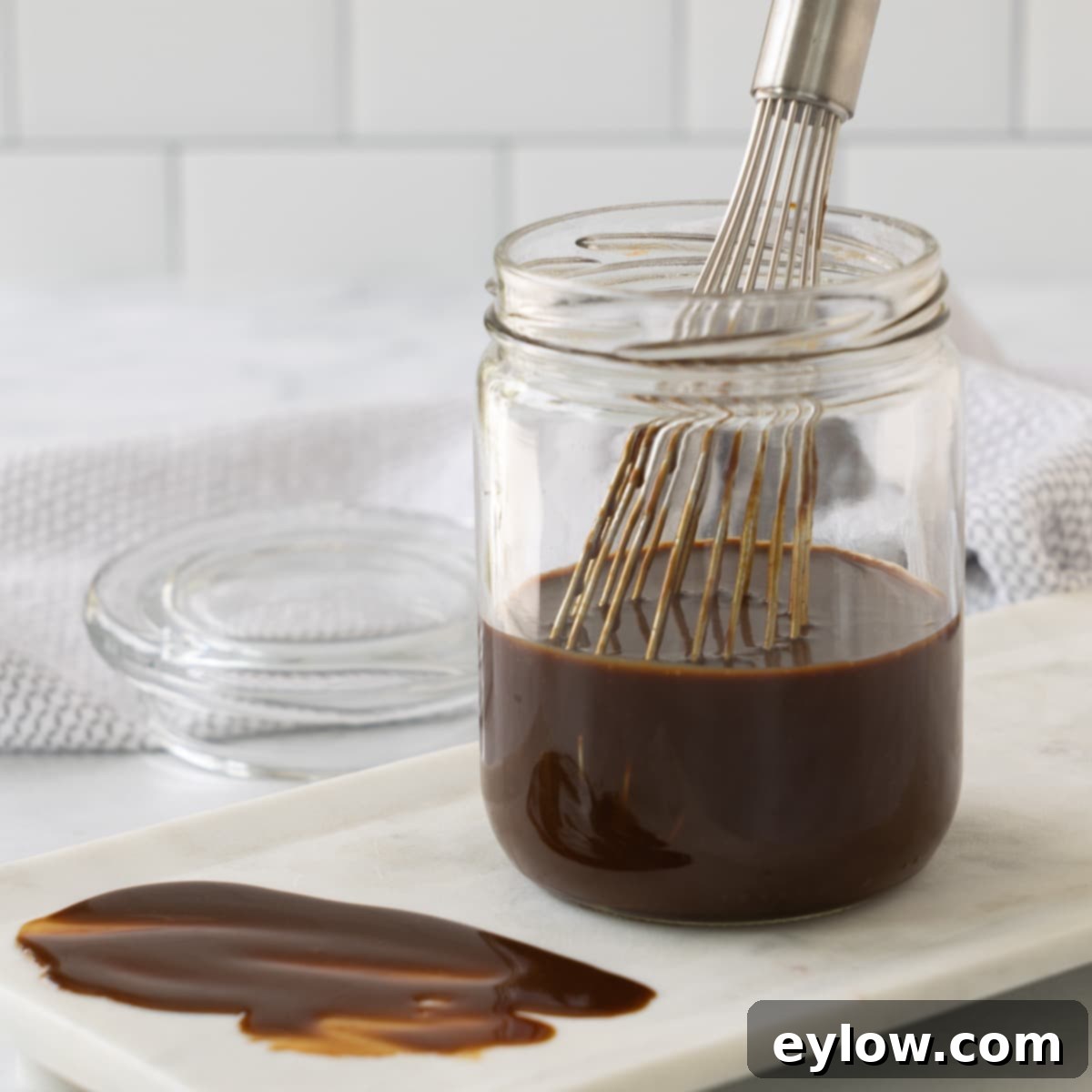Easy Homemade Gluten-Free Hoisin Sauce: Your No-Cook, Authentic Asian Flavor Secret
Discover the incredible ease of preparing your own gluten-free hoisin sauce at home in mere minutes, no cooking required! This homemade version perfectly balances sweet, salty, savory, and tangy notes, creating a truly marvelous sauce widely cherished in Asian cuisine. Hoisin sauce is wonderfully versatile; use it as a dipping sauce, a succulent glaze, or a flavorful stir-fry base. Once you try it, you’ll wonder how you ever managed without it! Think of it as the ultimate Asian barbecue sauce – rich, complex, and utterly irresistible. Our homemade recipe consistently outperforms store-bought varieties, offering superior flavor and quality.
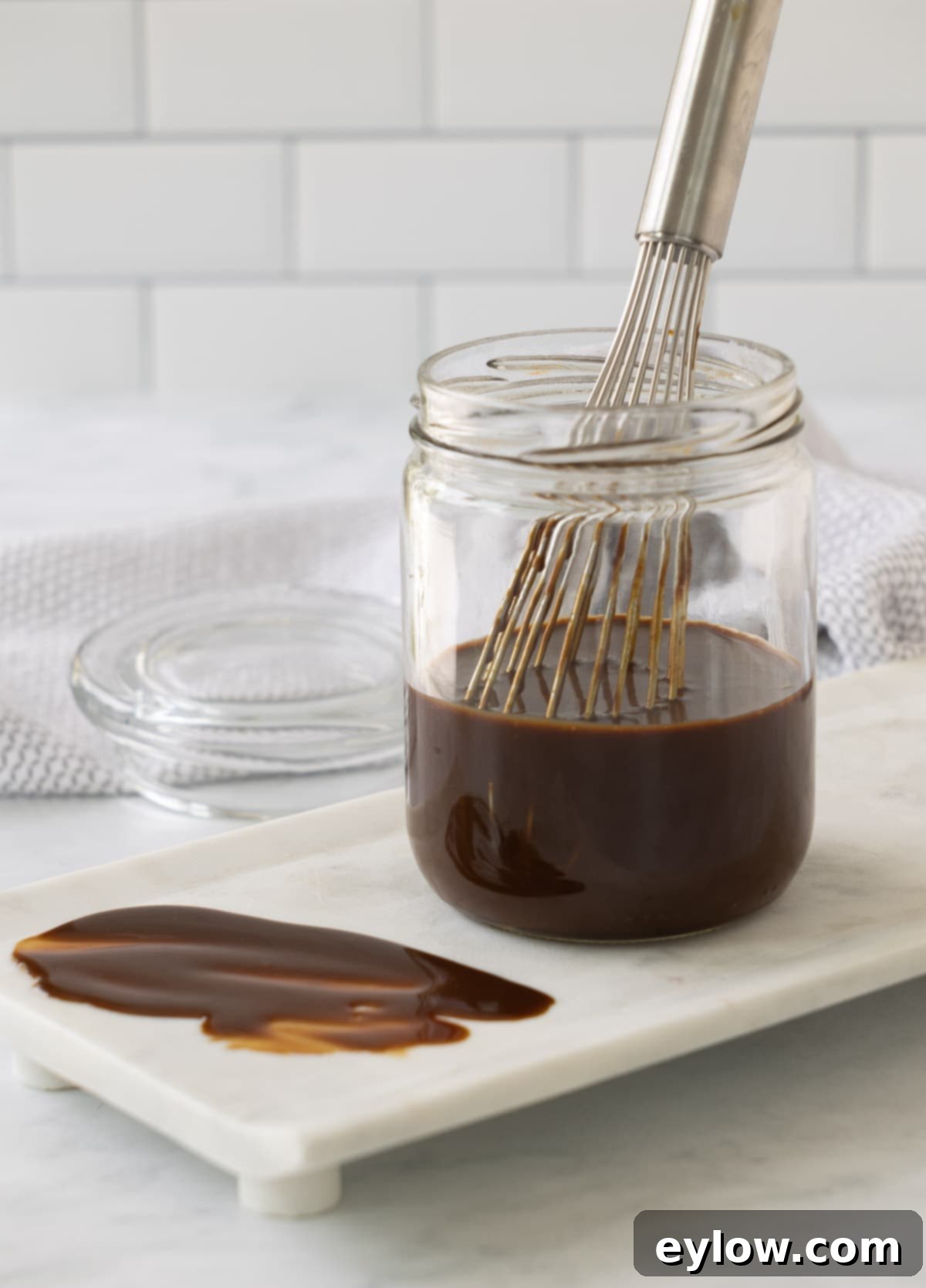
My culinary journey led me to a critical question: “Is hoisin sauce naturally gluten-free?” After examining the labels of numerous store-bought hoisin sauces, I was often surprised to find they contained hidden gluten and other undesirable ingredients. This revelation inspired me to create my own gluten-free hoisin sauce recipe. The result is simply the best – delivering all the authentic flavor and wonderfully thick texture I desired, but without lower-quality additives like caramel color, artificial dyes, modified corn starch, or wheat-based ingredients. Say goodbye to mass-produced bottles and hello to fresh, wholesome homemade goodness!
[feast_advanced_jump_to]
Why You’ll Love This Homemade Gluten-Free Hoisin Recipe
This recipe for homemade gluten-free hoisin sauce isn’t just a kitchen hack; it’s a game-changer for anyone looking to elevate their Asian-inspired dishes while adhering to a gluten-free diet or simply seeking cleaner ingredients. Here’s why this recipe will become a staple in your culinary repertoire:
- Effortless Preparation: This recipe is incredibly simple to make, requiring absolutely no cooking. All you need are a few pantry staples and a whisk or blender, and you’ll have a fresh batch ready in minutes. It’s perfect for busy weeknights or when you need a fantastic sauce in a pinch.
- Unmatched Versatility: This complex and richly flavored sauce can do it all. Use it as a marinade or glaze for grilled ribs, chicken, shrimp, and scallops. Toss it with stir-fries for an instant flavor boost, or mix it into ground meats for gourmet burgers. It’s also an exceptional dipping sauce for spring rolls, dumplings, or even fresh vegetables.
- Truly Gluten-Free: We prioritize your health and dietary needs by using tamari, a naturally wheat-free and gluten-free soy sauce alternative. This ensures that every drop of your homemade hoisin is safe and delicious for those with gluten sensitivities or celiac disease. You get all the robust umami flavor without any concerns about gluten.
- Superior Flavor & Quality: Unlike many commercial brands that often contain excessive sugar, sodium, and artificial ingredients, our homemade hoisin sauce allows you to control the quality and balance of flavors. You’ll taste the difference that fresh, wholesome ingredients make.
For another delightful Asian-inspired sauce recipe, be sure to try this homemade gluten-free teriyaki sauce. Or, use your freshly made gluten-free hoisin as a vibrant dipping sauce for these colorful vegetable spring rolls, creating a harmonious and healthy meal.
Essential Ingredients for Your Hoisin Sauce
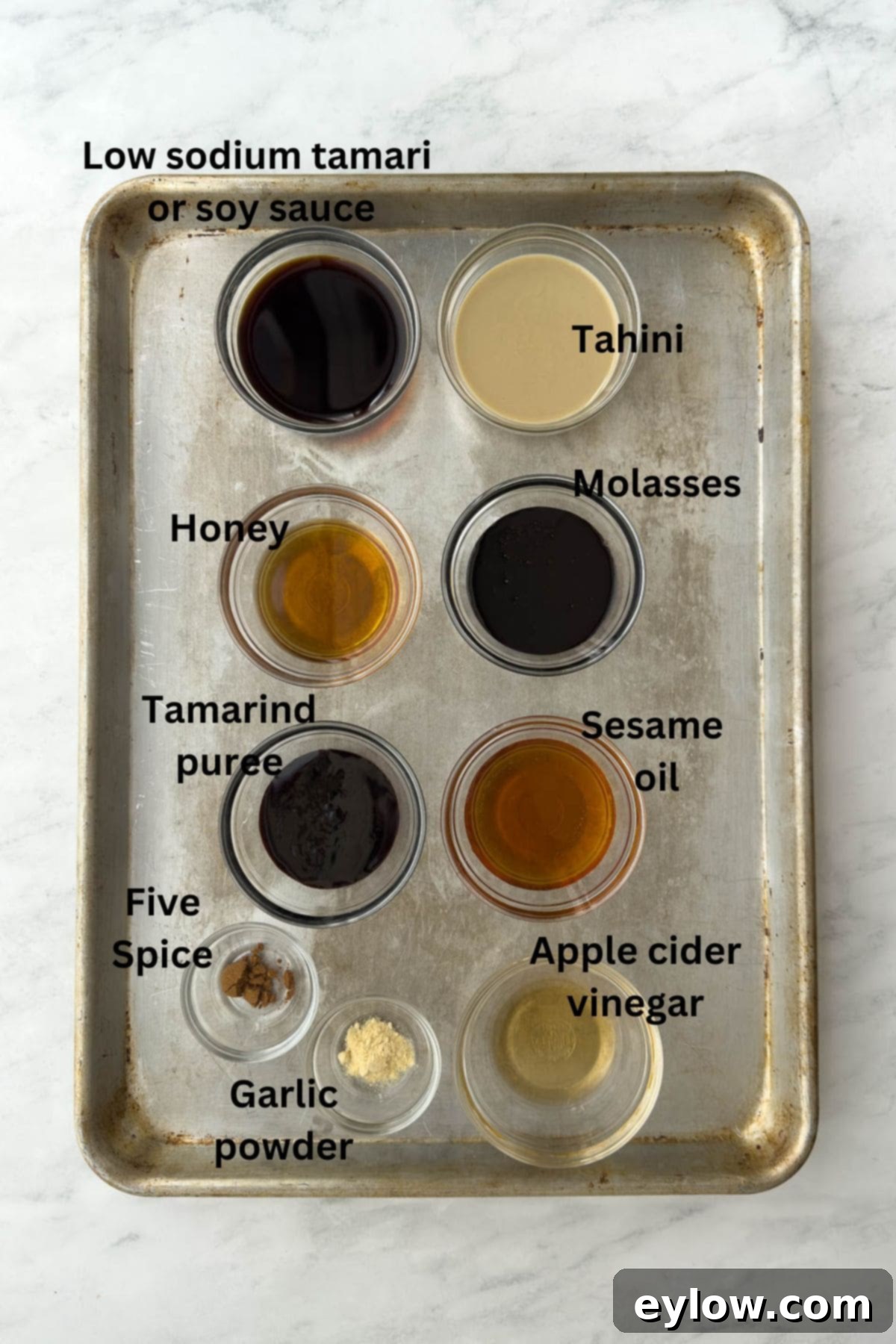
When developing this gluten-free hoisin sauce, I intentionally omitted an ingredient commonly found in many traditional recipes: fermented soybean paste (such as miso paste or black bean paste). After extensive testing, I discovered that adding these pastes often resulted in an overly salty sauce that overshadowed the other delicate flavors. While traditional, I found the sauce to be more balanced and enjoyable without it, allowing the natural sweetness and savory notes to shine through.
Our gluten-free hoisin delivers incredible rich flavor and a lower sodium profile without the need for bean paste. We achieve its delightful sweetness using honey instead of plum puree (which often comes with a lot of added sugar), and its deep, appealing color comes from a combination of tamari and molasses, avoiding artificial caramel coloring.
- Tamari: This is the cornerstone of our gluten-free sauce. Tamari is a wheat-free soy sauce that offers the same rich, umami depth as regular soy sauce but is suitable for gluten-free diets. For those mindful of sodium intake, I highly recommend opting for a 50% reduced sodium version. This particular brand of tamari is a favorite for its quality. If gluten isn’t a concern for you, feel free to use your preferred low-sodium regular soy sauce.
- Nut Butter: A crucial component, nut butter provides this sauce with its characteristic rich, creamy, and thick texture, while also contributing a wonderful depth of flavor. My top recommendation is tahini (sesame seed butter) because of its smooth consistency and relatively neutral flavor profile, which allows the other ingredients to come forward. See the substitutions section below for other excellent options.
- Molasses: A thick, dark brown syrup produced during the sugar refining process, unsulphured molasses is key to both the warm sweetness and the deep, rich color of this homemade hoisin. It’s essentially what gives brown sugar its distinctive hue. Be sure to avoid blackstrap molasses, as its flavor is typically too bitter for this application.
- Sesame Oil: This ingredient adds a distinctive, aromatic richness. For the most robust flavor and a deeper color, always use toasted sesame oil. Its nutty, intense aroma is indispensable to authentic Asian flavors.
- Honey: Serving as our primary sweetener, honey contributes a natural, mild sweetness. Opt for a liquid-style honey that blends easily into the sauce.
- Tamarind: While optional, I strongly encourage you to seek out this unique ingredient. Tamarind is a fruit-like legume known for its delightful sweet-sour taste, which adds an unparalleled complexity to the hoisin. I use Glory Bee organic tamarind puree, which is thick, pure, and free of additives or seeds (unlike block tamarind). You can often find it at Whole Foods, various ethnic markets, and online. Tamarind is a beloved staple in Indian, Mexican, African, Thai, and Latin-American cuisines and is sometimes labeled as tamarind paste.
- Vinegar: Apple cider vinegar is my preferred choice here, lending a mild acidity and bright tang that cuts through the richness of the sauce, balancing the sweetness and savory notes.
- Chinese Five Spice: This marvelous and exotic spice blend is a non-negotiable for authentic hoisin flavor. While blends can vary, they typically include szechuan pepper (or black pepper), cinnamon, clove, fennel, and star anise, along with other warm spices. If you appreciate the warm, comforting notes of cinnamon, you are sure to fall in love with Five Spice.
- Garlic: For this no-cook gluten-free hoisin sauce, garlic powder is perfectly acceptable and often preferred over fresh garlic, as it disperses more evenly without requiring sautéing or mincing.
For precise measurements, please refer to the recipe card provided below.
Chef’s Note: Hoisin sauce originates from Cantonese cuisine but has found widespread use and adaptation in Vietnamese, Japanese, and other Asian-inspired dishes around the world. If you’ve previously relied on bottled brands like Kikkoman hoisin sauce or Lee Kum Kee hoisin sauce, I urge you to try this homemade recipe for a fresher, more customizable experience!
Customizing Your Hoisin Sauce: Substitutions and Variations
One of the joys of making your own sauces is the ability to adapt them to your taste preferences or dietary needs. Here are a few clever substitutions and variations for my homemade hoisin sauce recipe:
- Nut Butter Swaps: While tahini offers a neutral and creamy base, you can experiment with other creamy nut butters. Try creamy almond butter, cashew butter, or even creamy peanut butter. Each will impart a slightly different flavor profile to your hoisin sauce. I’ve personally tested them all, and while tahini remains my top choice for its mildness, these alternatives offer delicious variations.
- Vinegar Alternatives: If apple cider vinegar isn’t readily available, unseasoned rice vinegar makes an excellent substitute, providing a similar mild acidity and tang.
- Sugar Reduction or Vegan Option: For those looking to reduce sugar content or seeking a vegan alternative to honey, I highly recommend this fantastic keto honey syrup. It’s a terrific substitute that maintains the sweetness without the sugar or animal products.
- Date Syrup: Another natural sweetener option is date syrup. While I haven’t personally tested it in this specific recipe, its rich, caramel-like sweetness could provide an interesting depth of flavor.
- Maple Syrup: Maple syrup can also be used as a sweetener, but be aware that its distinct flavor will subtly alter the overall taste of your hoisin sauce. If you enjoy maple, it can be a delightful twist.
Chef’s Tip: Chinese Five Spiceis truly a marvelous and exotic blend that deserves a prime spot in your spice rack. Don’t limit its use to just Asian cuisine! Try incorporating it wherever you’d typically use cinnamon – it’s especially phenomenal paired with chocolate! For adventurous palates, experiment with five spice in my chocolate energy smoothie or this decadent recipe for chocolate pudding (chocolate pots de creme) for a surprising and delightful flavor kick.
Simple Steps to Make Homemade Hoisin Sauce
Making this homemade gluten-free hoisin sauce is incredibly straightforward. It truly couldn’t be any easier! The entire process involves just two simple steps: measuring your ingredients and then blending them together. No complex cooking techniques, no simmering, just pure simplicity.
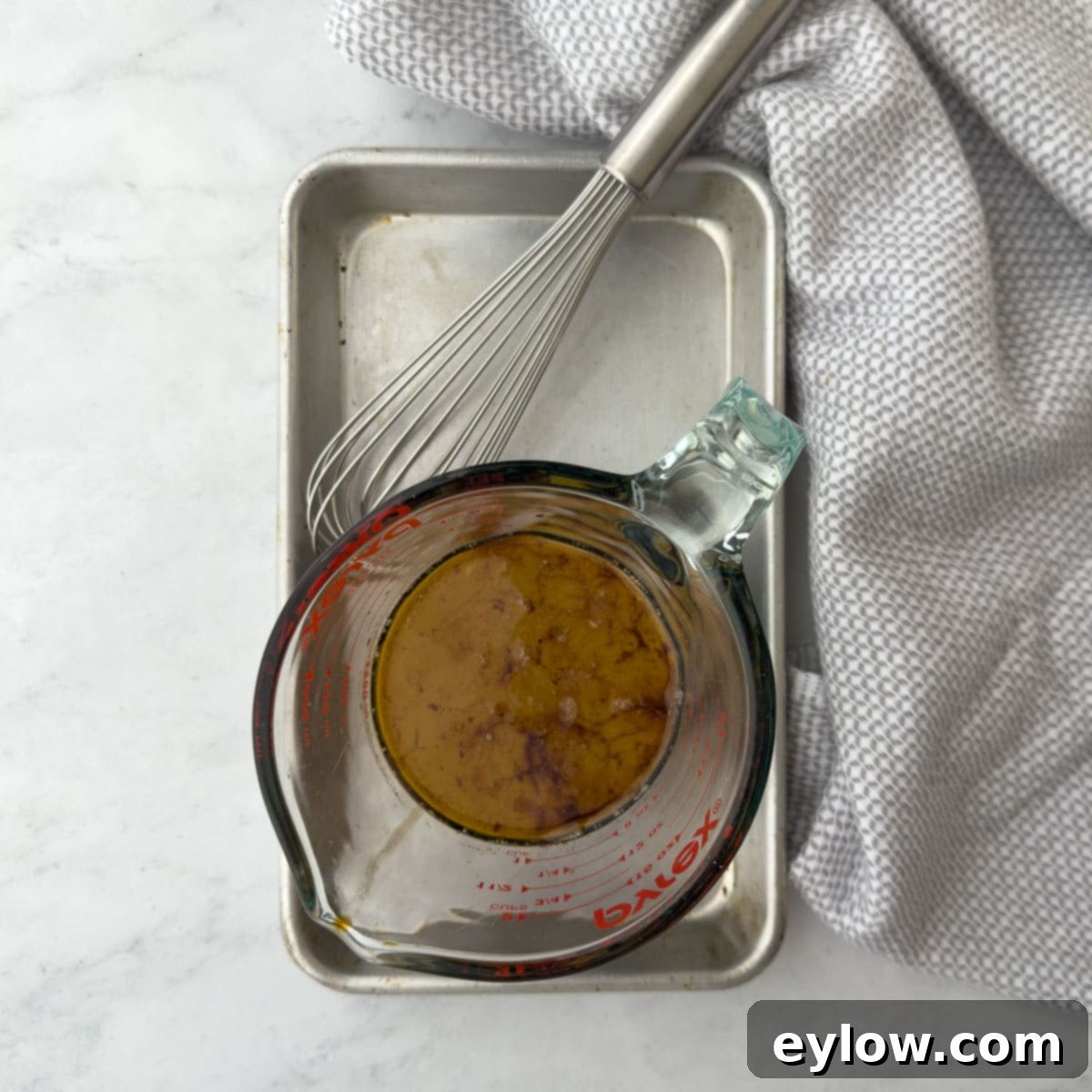
Step 1: Combine and Blend. Gather all your ingredients and add them into a jar with a tight-fitting lid, or a medium-sized bowl if you prefer. Using a whisk, vigorously stir until all the ingredients are thoroughly combined and the mixture is silky smooth. For an even quicker and smoother result, you can also transfer all the ingredients to a blender and blend on a low setting until uniform. There’s no need for any cooking to achieve the desired thick consistency, as the nut butter (tahini, almond, or cashew) naturally provides that rich, creamy texture. And just like that, you’re done! It’s truly that simple to create a fresh batch of delicious hoisin sauce.

Chef’s Tip: What else can you create with versatile tamarind puree? Beyond its role in our delicious gluten-free hoisin sauce, tamarind puree is a fantastic ingredient for a myriad of culinary applications. Use it to craft flavorful jams, zesty chutneys, and other vibrant condiments. It makes an incredible base for glazes, adds depth to homemade barbecue sauces, brightens salad dressings, and can even be used to create unique beverages or stir-fry dishes. Its distinctive sweet-tart flavor, often described as a delightful cross between lemons and sweet dates, is truly unique. If you enjoy the savory depth of Worcestershire sauce, you’ll find a similar, albeit more pronounced, tangy note in tamarind, as it’s a key ingredient in many traditional Worcestershire recipes. Seriously, it’s absolutely delicious and adds an exotic touch to so many dishes!
Versatile Serving Suggestions for Your Homemade Hoisin
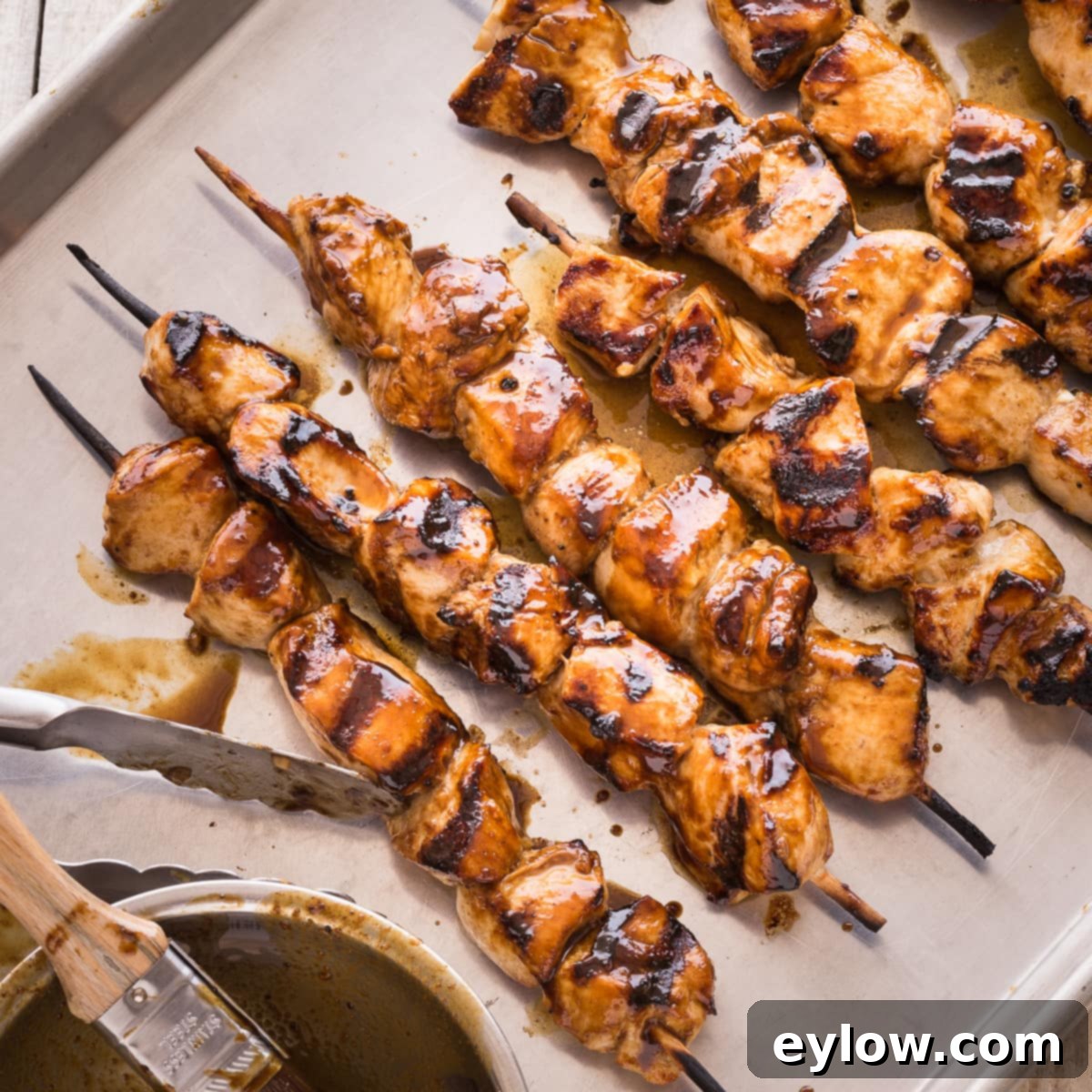
This homemade gluten-free hoisin sauce is incredibly versatile and will quickly become your go-to for adding an authentic Asian flair to a variety of dishes. Here are some of my favorite ways to enjoy it:
- Chicken Kabobs: Elevate your next barbecue by brushing grilled chicken kabobs (as pictured above) with a generous layer of gluten-free hoisin sauce during the last few minutes of cooking. This creates a beautiful, caramelized glaze and infuses the chicken with fantastic, complex flavors. Don’t forget to serve extra hoisin on the side as a dipping sauce!
- Baby Back Ribs: For a truly show-stopping meal, this gluten-free hoisin sauce is absolutely stellar on oven-baked baby back ribs. The rich, savory-sweet glaze adheres perfectly, creating tender, fall-off-the-bone ribs that are packed with flavor.
- Seared Seafood: Transform simple seafood into a gourmet delight. Glaze perfectly seared jumbo sea scallops with hoisin, or brush it onto other fish dishes like this easy sesame salmon. The sauce adds a vibrant sweetness and umami depth that complements the delicate flavors of seafood beautifully.
- Stir-Fries and Noodle Dishes: Use it as a base for your favorite stir-fries, coating vegetables, tofu, or meat with its luscious flavor. It’s also fantastic tossed with cold Asian-style noodle salads for a refreshing and hearty meal.
- Burgers and Sandwiches: Think outside the box! Spread a layer of hoisin on your burger buns or mix it directly into ground meat for a unique and flavorful twist on classic burgers. It also makes an exciting condiment for pulled pork or chicken sandwiches.
Keep in mind that homemade gluten-free hoisin sauce, particularly due to the nut butter content, will become very thick when refrigerated. To achieve a thinner, more pourable consistency for glazing or drizzling, simply add a little water, a teaspoon at a time, whisking until you reach your desired texture. Alternatively, you can gently warm the sauce over low heat in a small saucepan, which will also help thin it out. I generally don’t recommend microwaving, as it can sometimes alter the texture unevenly.
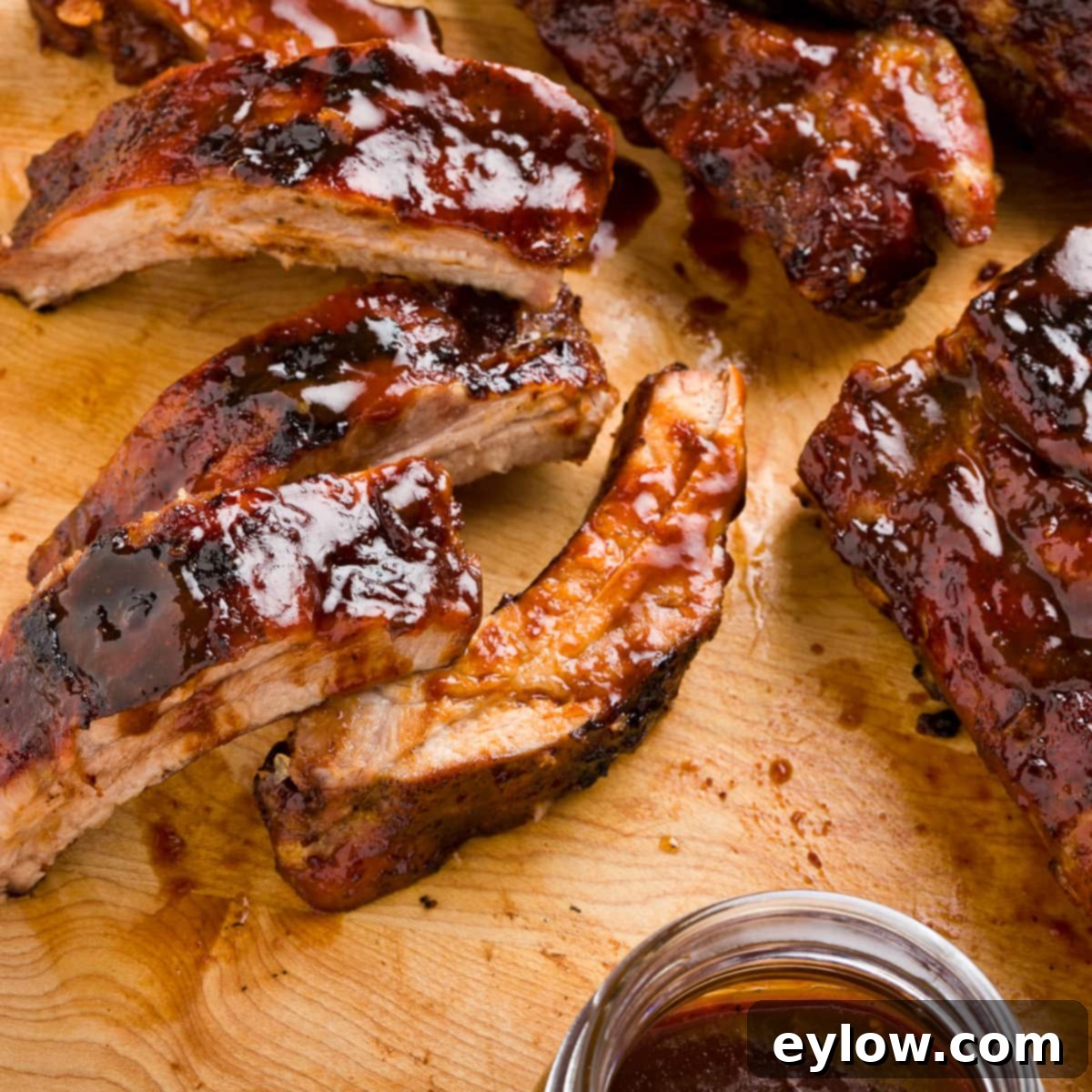
Frequently Asked Questions About Hoisin Sauce
Navigating the world of Asian sauces, especially with dietary restrictions, can bring up several questions. Here are some of the most common inquiries about hoisin sauce and its gluten-free status:
Traditionally, many store-bought hoisin sauces are NOT gluten-free because they typically contain regular soy sauce, which is made with wheat. However, hoisin sauce can absolutely be made gluten-free by substituting regular soy sauce with tamari. Tamari is a fantastic wheat-free alternative that offers the same rich, savory flavor profile as traditional soy sauce, making it perfect for gluten-free recipes. Always remember to read ingredient labels carefully when purchasing bottled hoisin sauce to ensure it explicitly states “gluten-free,” as formulations can vary significantly between brands. Our homemade recipe uses tamari, guaranteeing a delicious and safe gluten-free experience.
Teriyaki sauce can sometimes serve as a decent alternative to hoisin sauce in certain recipes, primarily due to their similar consistency and shared base ingredient of soy sauce (or tamari) and a sweetener. However, it’s important to note that while they share some structural similarities, their flavor profiles are quite distinct. Hoisin sauce typically offers a more complex blend of sweet, salty, tangy, and savory flavors, often with notes of five spice, garlic, and sometimes plum or bean paste. Teriyaki, on the other hand, is generally sweeter and more ginger-forward, with less of the deep, earthy undertones found in hoisin. Both are delicious in their own right, but the choice between them will significantly impact the final taste of your dish. If you’re looking for an authentic hoisin flavor, a dedicated hoisin recipe is always best.
Yes, it is possible to find bottled gluten-free hoisin sauce in specialty stores or online, but it’s not universally available and can sometimes be more expensive. While convenient, homemade gluten-free hoisin sauce is often a far superior option. When you make it yourself, you have complete control over the ingredients, allowing you to avoid artificial colors, preservatives, and regulate the levels of sodium and sugar, both of which are notoriously high in many commercial brands. The fresh flavor and customizable nature of homemade hoisin truly make it worth the minimal effort.
Oyster sauce and hoisin sauce are both popular, thick, dark brown sauces widely used in Asian cooking, but they possess distinctly different flavor profiles. Oyster sauce, as its name suggests, is made from oyster extracts, along with sugar, salt, water, often modified corn starch, and typically caramel color and MSG. Its flavor is savory and umami-rich, with a subtle sweetness and a hint of brininess, sometimes described as mildly “fishy” for some palates – it can be more of an acquired taste. Hoisin sauce, conversely, is a vegetarian sauce (in its traditional form, though always check labels) that is sweet, salty, savory, and tangy, often featuring garlic, chili, and five spice. It doesn’t contain oyster extract or fish sauce (though some modern recipes might incorporate fish sauce for an extra umami kick if desired). While both are used for glazing, marinading, and stir-frying, oyster sauce tends to enhance the natural flavors of ingredients, whereas hoisin sauce often takes center stage with its bolder, more pronounced taste.
More Delicious Sauce Recipes to Explore
If you’ve enjoyed crafting this incredible homemade hoisin sauce, you’re in for a treat! Our kitchen is brimming with a variety of easy and delicious sauce and dressing recipes designed to elevate your everyday meals. From vibrant vinaigrettes to rich, savory condiments, you’ll find something to inspire every palate and dish. Be sure to check out our dedicated sauces and dressings category for more fantastic ideas that are simple to make and packed with flavor!
- Easy Homemade Italian Salad Dressing
- Fast and Fresh Strawberry Coulis
- How to Make Homemade Mayonnaise (with herbs)
- Creamy Mango Sauce
⭐️Share Your Hoisin Creation and Rate the Recipe!
We absolutely love hearing from you! If you decide to make this delicious homemade gluten-free hoisin sauce, please take a moment to add your comment below. Your feedback is invaluable and it brings us so much joy to hear about your culinary successes. If you loved the recipe as much as we do, please consider giving it a 5-star rating! Your ratings truly help other readers discover and enjoy this wonderful sauce, and it means the world to us.
📖 Recipe

Homemade Hoisin Sauce
Sally Cameron
Pin Recipe
Ingredients
- ¼ cup low sodium gluten-free Tamari or low sodium soy sauce
- ¼ cup tahini (sesame seed butter) swaps below
- 3 tablespoons honey
- 2 tablespoons molasses
- 2 tablespoons sesame oil
- 2 tablespoon jarred tamarind puree
- 1 tablespoon apple cider vinegar or unseasoned rice vinegar
- ¼-1/2 teaspoon Five Spice Powder aka Chinese five spice
- ¼ teaspoon garlic powder
Instructions
-
Combine all ingredients into a large measuring cup or bowl. Whisk until smooth. You could even toss all of the ingredients into a blender and whirl to blend. Taste, and if you want it sweeter add a little more honey. Store covered and refrigerated in a jar for 30 days.
Notes
For less sugar (and vegans), use this keto honey made with monk fruit.
For tamari look for the 50% reduced style for lower sodium.
Gluten-free hoisin is very thick when cold after refrigeration, so depending on use you may need to thin. Use a little water. You can also warm it up on low heat in a small pan.
